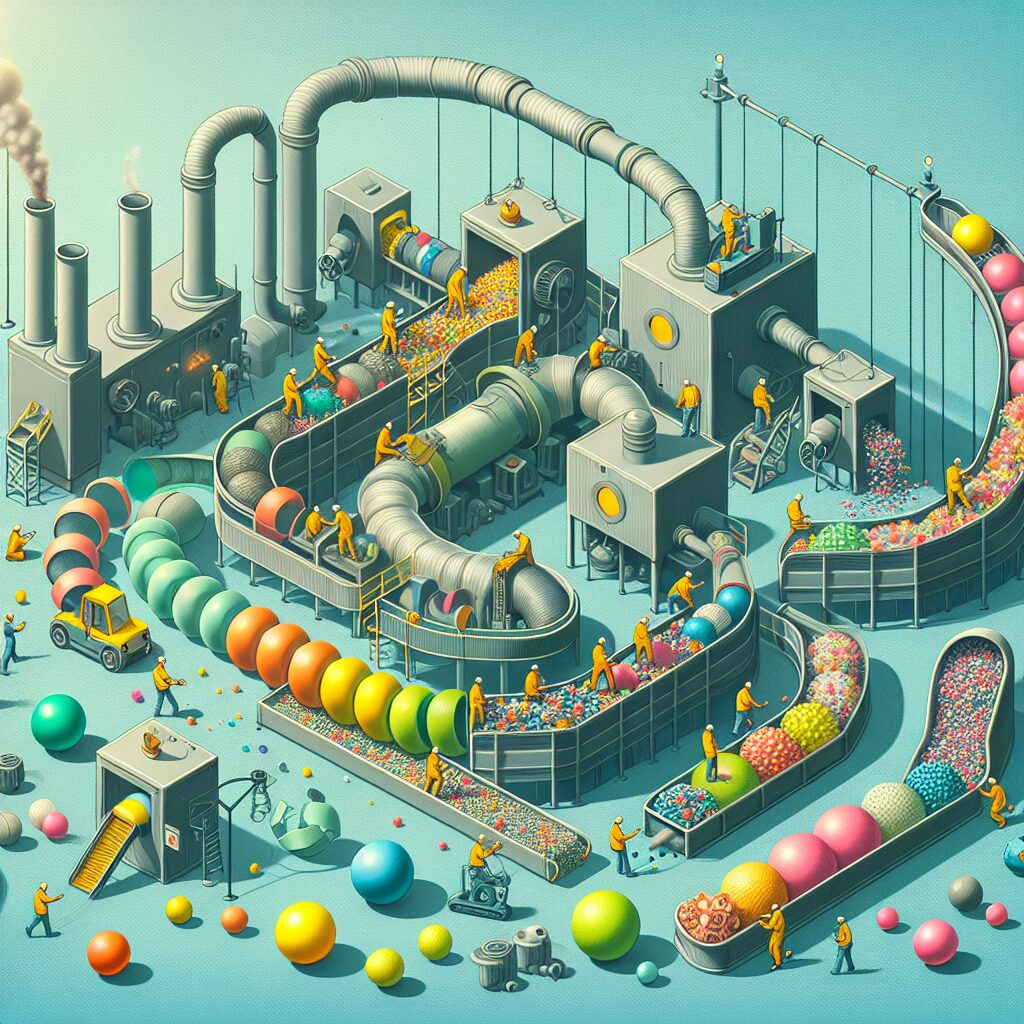Circular economy is a term that has gained significant attention in recent years, particularly in the context of sustainability and resource efficiency. Simply put, it refers to a system where resources are used, reused, and recycled in a closed loop, minimizing waste and environmental impact. This concept is not only applicable to traditional industries, but also extends to unlikely candidates such as balls used in sports and recreational activities.
Balls, whether for soccer, basketball, or tennis, have long been considered as single-use items with a limited lifespan. However, by reimagining the production and disposal process, these seemingly mundane objects can become key players in promoting a circular economy. Instead of the traditional linear approach of producing balls from virgin materials, alternative methods like using recycled materials or designing balls for easy refurbishment and disassembly can significantly reduce the environmental burden associated with their creation. By considering the entire lifecycle of balls, from production to end-of-life, a circular approach can result in extended product lifespans, reduced waste generation, and resource preservation.
In the upcoming sections, we will delve deeper into the key takeaways of implementing circular economy principles in the production of balls. We will explore the environmental and economic benefits of utilizing recycled materials and discuss innovative designs that enable easy refurbishment and recycling. Furthermore, we will uncover the challenges faced by manufacturers in transitioning to circular practices and highlight successful case studies that have paved the way for a more sustainable approach. So, let us embark on this journey towards closing the production loop and creating a more sustainable future for balls and beyond.
Key Takeaways
1. The concept of a circular economy seeks to eliminate waste and promote the reuse of resources, and it is increasingly being applied to various industries, including sports equipment manufacturing.
2. The collaboration between a sports equipment company and a recycling organization resulted in the development of a closed-loop system for tennis balls, where worn-out balls are collected, deconstructed, and repurposed into new balls.
3. The closed-loop system not only reduces the environmental impact of tennis ball production but also addresses the issue of unused tennis balls ending up in landfills. By reusing materials, the system significantly decreases the amount of waste generated.
4. The newly repurposed tennis balls have gone through a rigorous testing process to ensure that they meet the required performance standards. This successful outcome highlights the potential for circular economy models to improve sustainable manufacturing practices in the sporting goods industry.
5. Implementing circular economy principles in the sports sector not only benefits the environment but also presents new business opportunities for companies as consumers increasingly prioritize eco-friendly products. The successful integration of circular practices can contribute to a more sustainable and resource-efficient future.
How Can Circular Economy and Balls: Closing the Production Loop Lead to Sustainable and Efficient Production?
Introduction to Circular Economy and Balls: Closing the Production Loop
Circular economy refers to an economic system that aims to minimize waste and maximize the value of resources. In this system, materials are kept in use for as long as possible, and their value is preserved through effective recycling and reuse processes. One interesting application of the circular economy concept is in the production of balls, where closing the production loop can lead to sustainable and efficient practices. This article explores the various aspects and benefits of Circular Economy and Balls: Closing the Production Loop.
Benefits of Circular Economy in Ball Production
1. Resource Efficiency
In a circular economy approach to ball production, resources are conserved and optimized. Materials like rubber, synthetic polymers, and textiles can be recycled effectively, reducing the need for extracting raw materials and minimizing waste generation.
2. Environmental Sustainability
By closing the production loop, the environmental impact associated with ball production can be significantly reduced. This includes reducing greenhouse gas emissions, conserving water, and minimizing the use of energy during both production and disposal processes.
3. Cost Effectiveness
Implementing circular economy principles in ball production can lead to cost savings. By reusing materials and reducing waste, manufacturers can lower their raw material costs and disposal expenses, making their production processes more economically sustainable.
Closing the Production Loop in Ball Production
1. Design for Recyclability
Manufacturers should consider designing balls that are easily recyclable by using materials that can be effectively processed in recycling facilities.
2. Establish Circular Supply Chains
Collaboration between ball manufacturers, suppliers, and recycling facilities is crucial to implementing circularity. Establishing efficient supply chains enables the proper collection, sorting, and recycling of materials, ensuring the closed loop system works effectively.
3. Embrace Eco-friendly Materials
Using eco-friendly materials like natural rubber or biodegradable alternatives reduces the environmental impact associated with ball production, contributing to the circular economy objectives.
4. Implement Reverse Logistics
By implementing reverse logistics practices, manufacturers can effectively collect used balls, refurbish them, and reintroduce them into the supply chain, extending their lifespan and reducing waste.
Conclusion
Circular economy principles have the potential to revolutionize ball production by closing the production loop and adopting sustainable practices. By focusing on resource efficiency, environmental sustainability, and cost-effectiveness, manufacturers can contribute to a more circular and sustainable future. Embracing the concept of Circular Economy and Balls: Closing the Production Loop benefits not only the environment but also the economy and society as a whole.
Guides for Implementing Circular Economy and Balls: Closing the Production Loop
1. How can ball manufacturers design for recyclability?
2. What steps should be taken to establish circular supply chains in ball production?
3. Which eco-friendly materials can be used in ball manufacturing?
4. What are the best practices for implementing reverse logistics in the ball industry?
Frequently Asked Questions
What is a circular economy?
A circular economy is an economic system that aims to eliminate waste and continuously reuse resources, creating a closed-loop system. It promotes the reuse, refurbishment, and recycling of products and materials to minimize the extraction of raw materials and reduce environmental impact.
How does the circular economy relate to the production of balls?
The circular economy is particularly relevant to the production of balls as it encourages the use of sustainable materials, designs, and manufacturing processes. It promotes the idea of prolonging the lifespan of balls, repairing them when necessary, and recycling materials to produce new ones, minimizing waste generation.
What are the benefits of applying circular economy principles to ball production?
Applying circular economy principles to ball production offers numerous benefits. It reduces the consumption of natural resources, minimizes waste generation, decreases environmental pollution, and contributes to the conservation of ecosystems. Additionally, it can drive innovation, create new jobs, and improve the overall sustainability of the sports industry.
How can circular economy principles be implemented in ball production?
Circular economy principles can be implemented in ball production through various strategies. These may include using recyclable or biodegradable materials, designing balls for durability and easy repair, establishing take-back or recycling programs, and collaborating with suppliers and manufacturers to create closed-loop systems.
Does adopting a circular economy approach increase the cost of ball production?
While initially, the adoption of circular economy principles may require additional investments, it can lead to long-term cost savings. By reducing the need for raw materials and minimizing waste disposal costs, businesses can optimize their resource use and achieve greater efficiency, ultimately resulting in cost reductions.
How can consumers support the circular economy in relation to ball production?
Consumers can support the circular economy in relation to ball production by choosing products made from sustainable materials, promoting the repair and reuse of balls instead of purchasing new ones, and participating in recycling initiatives. Additionally, raising awareness about the importance of circular economy principles within their communities can encourage others to adopt sustainable practices.
What challenges may arise when implementing a circular economy in ball production?
Implementing a circular economy in ball production may face challenges such as finding appropriate recycling facilities for specific materials, ensuring the availability of sustainable materials in sufficient quantities, and changing consumer behaviors and preferences. Overcoming these challenges requires collaboration among stakeholders, innovative solutions, and increased awareness and education.
Is the circular economy only applicable to large-scale ball manufacturers?
No, the circular economy is applicable to entities of all sizes, including small-scale ball manufacturers. In fact, small businesses can often more easily implement circular economy principles due to their flexibility and agility. Embracing sustainability in ball production can be a competitive advantage for businesses of any scale.
What role does innovation play in the circular economy and ball production?
Innovation plays a crucial role in the circular economy and ball production. It drives the development of new materials, technologies, and processes that enable the reuse, repair, and recycling of balls. Innovations can lead to more sustainable designs, improved durability, and efficient material recovery, ultimately advancing the circular economy in the sports industry.
How can the circular economy and ball production contribute to a more sustainable future?
The circular economy and ball production can contribute to a more sustainable future by reducing resource depletion, minimizing waste generation, and mitigating environmental impact. By closing the production loop, we can preserve natural resources, conserve energy, and promote a circular mindset that values reuse and regeneration, ultimately creating a more sustainable and resilient society.
Final Thoughts: Closing the Production Loop for a Sustainable Sporting World
The incorporation of circular economy principles in the production of balls holds immense promise for building a sustainable sporting world. By shifting our perspective from linear consumption to circular practices, we have the opportunity to transform the way balls are made, used, and disposed of. Embracing durable designs, recycling initiatives, and promoting responsible consumption can safeguard precious resources, reduce waste, and pave the way for a greener future.
As manufacturers, consumers, and policymakers converge towards circularity, collaboration becomes vital. Through partnerships, research, and shared knowledge, we can overcome the challenges that lie ahead and accelerate the adoption of circular economy principles in the sports industry. By closing the production loop for balls and other sporting goods, we can inspire positive change, foster innovation, and contribute to a more sustainable and resilient world for generations to come.




